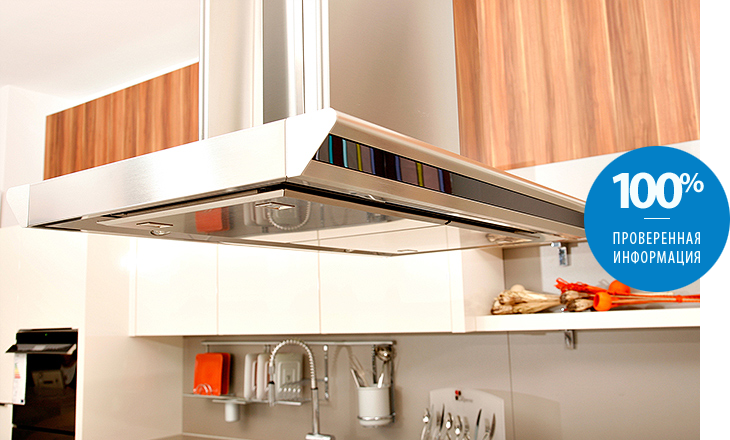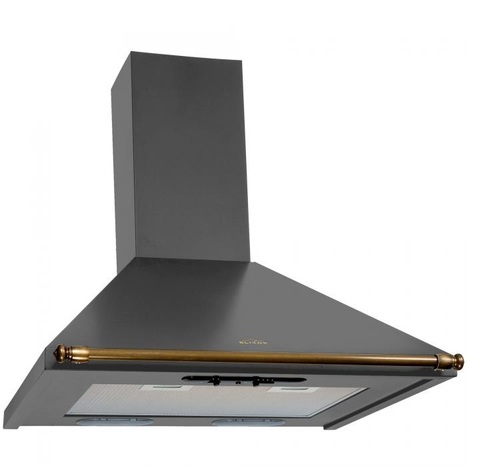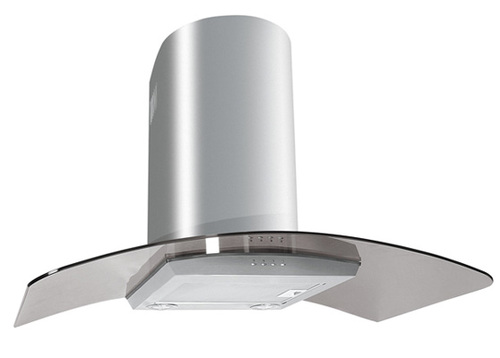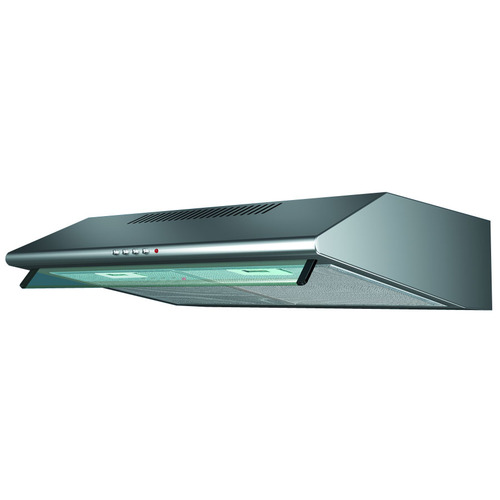
The kitchen is the place where every housewife spends most of the time. In addition, it is in the kitchen that the whole family gathers in the evenings to take a break from worries and dine. Therefore, it is important to take care that the smells left after cooking do not interfere with warm family communication, and splashes and residues of food do not spoil furniture and household appliances. How to achieve this? Of course, with the help of buying a modern kitchen hood, which cleans the air and will save expensive repairs from grease and other contaminants.
To choose the optimal hood for your kitchen, first of all, you need to consider several of the most important criteria: type of installation, operating modes, performance and filtration system.
Type of installation
According to the type of installation and its design, kitchen hoods are divided into several types.
Traditional or suspended
Hoods that are mounted directly under the kitchen cabinet or above the stove. They are the most budget and, due to their small size, they are excellent for small-sized kitchens. Suspended models have low-power motors (one or more) and, as a rule, operate in recycling mode. Completed such extracts often disposable acrylic filters that catch the fat. Additionally, the hood can be equipped with a carbon filter, which retains the smallest particles of food and slightly neutralizes the smell, and replace the acrylic filter with a metal one. Suspended models, which are joined by an additional corrugated hose, are much more expensive, but they clean the air much better.
Embedded
They are mounted in a special box or kitchen cabinet in such a way that only a small front panel can be seen. Some built-in hoods are equipped with a sliding panel, which increases the area of the intake of fumes. This improves productivity and facilitates instrument operation. On sale there are models that are installed between two kitchen cabinets. In this case, the front part is hidden behind a false panel, which is veneered like the rest of the headsets. As a rule, built-in hoods have two engines and multi-layer grease filters at once.
Dome
Dome hoods are catchy design and high cost. Domed design allows you to effectively eliminate fumes and odors from the kitchen. Extracts of this type are divided into:
- Wall (fireplace) - attached horizontally to the stove or hob or tilted. Wall hoods are most popular among consumers.
- Island - Mounted directly to the ceiling, so that they can be located in any part of the kitchen. Such hoods, as a rule, have good performance, are distinguished by a wide variety of design solutions and a fairly high price.
- Corner- A special design allows you to attach the hood in the corner of the room. But this option is not too common due to the high cost and small range.
Also before buying it is advisable to measure the width and depth of the niche in which the hood will be installed. Ideally, the size of the hood should match the cooking surface or have an even wider air intake umbrella.

Photo: granfosto.ru
Performance
Appearance is not all that it is important to think about when choosing a hood for the kitchen. One of the most important features that you should pay attention to is performance and power. Here we will talk about how much cube. m of air can clean the hood for one hour of work.
The larger the kitchen area, the correspondingly, the greater performance should have an extractor hood. However, the concentration of harmful substances in the air of small kitchens can be several times higher than in the spacious ones. Therefore, it is imperative that the air polluted by evaporation is worked out quickly, which can only be done by extractors working with high power.
It is advisable to calculate the required drawing capacity even before going to the store. To do this, measure the area of the kitchen, taking into account the length, width and bends of the duct, if a flow model is purchased. After this, the area of the room should be multiplied by the height of the ceiling. The result obtained should be multiplied by another 12 (the sanitary standard, that is, the air in the kitchen should be updated 12 times per hour), and then by 1.3 (which equals the potential reserve ratio). For example, for a kitchen with an area of 7.5 meters and a ceiling height of 3 meters, you should choose an exhaust hood with a capacity of at least 351 cubic meters. m / h
It should be borne in mind that the performance primarily depends on the power of the exhaust. At the same time, power indicators in household models are rarely higher than 500 W, however, this is also sufficient for high performance.
Modes of operation
Cooker hoods can operate in the mode of air exhaust, circulation, or in both modes at once.
- Withdrawal mode - polluted air is brought directly to the street with the help of a ventilation system. Thus, the room is cleaned quickly and efficiently, but along with the polluted air, it can also be warm outside. In addition, not every kitchen has the ability to connect to a ventilation system. It is also worth considering that the air duct, which is attached to the internal kitchen wall, can significantly spoil the interior.
- Circulation mode - Passing through several filters, the air is cleaned and then returned back to the room. This mode is useful if there is no desire or ability to carry out an additional air duct. But this way of cleaning the kitchen is less effective than a full intake of dirty air from the kitchen, and regular replacement of filters cannot be avoided. Therefore, the first thing you need to pay attention to when buying a model that works exclusively in recirculation mode is the internal filters. There should be at least two of them: fatty - for coarse pre-cleaning and coal - for odor absorption and thorough filtration of polluted air.
- Mode of withdrawal and circulation- such extracts combine the two previous modes, thanks to which they effectively clean the room from unpleasant odors in the summer, taking the fumes to the street, and in winter retain heat while working in the circulation mode.

Photo: stroit64.ru
Filters
The exhaust can not be called a full-fledged air cleaner, but thanks to the filter system, polluted air is perfectly cleaned from the smallest fatty particles and extraneous odors. Modern hoods are equipped with several types of filters: grease, acrylic and carbon.
Fatty - retain on their surface particles of fat and soot and, mainly, are used in exhaust hoods. In total there are two types of fatty filters:
- Disposable - made from organic fibers, but require regular replacement. You can purchase such a filter only in the warranty service center. This option is convenient, but expensive.
- Reusable - made from steel or aluminum. Wash with powder or dishwashing detergent.
Coal- are intended for circulation hoods. It is necessary to change them from once a couple of months to once a year. The charcoal filter picks up odors and, with the aid of granules of activated carbon, purifies them from the air.
Acrylic -protect the engine of the device from hit of fatty particles Such a filter is also subject to regular replacement.
For ease of use, many models of hoods are equipped with special indicators that signal the need to change the filter.
Additional selection criteria
Noise level
The noise that a hood creates during operation can be annoying and distracting. In this case, the greater the performance of the device, the higher the noise level may be, which may depend on many factors: the diameter of the duct, its length, the presence of bends, etc. That is why, being on the trading floor, it is quite difficult to determine by ear the actual noise level. When buying, it is better to focus on the noise indicators (measured in dB) specified in the instructions:
- 45 dB - these indicators have the quietest working devices;
- 50 dB - the average noise level and the norm for most extracts;
- 55 dB - quite noisy, but with powerful exhaust;
- 60 dB or more - very high noise level, harmful.
To achieve low noise performance, manufacturers equip exhaust hoods with special anti-vibration pads separating the motor and the housing, and sound-absorbing plates.
Lighting
Lighting is implemented in hoods using various lamps. Low-end models, as a rule, are equipped with one lamp, and the more expensive ones have from three to five lamps. There are hoods with light focusing, light scattering, and some models have built-in sensors that respond to human approach.
Additional features
Many hoods have a variety of useful features, such as:
- Residual stroke, allowing after the complete shutdown of the hood to clean the room.
- Interval mode, providing independent switching on of the appliance at the lowest power level with an interval of 5-10 minutes, due to which the air in the kitchen will be updated regularly.
- Electronic timer turns off the hood after a certain period of time.
- Remote control is present in expensive models that are equipped with a remote control that allows you to control the exhaust from a distance. Some models have a remote control type, with which you can adjust the operation of the device from a smartphone or computer.
The most popular manufacturers of kitchen hoods
- Recognized leaders among manufacturers of kitchen hoods are popular brands. Bosch, Electrolux, AEG, Faber, Cata. Their products are of high quality and reasonable price.
- Premium class hoods are produced by companies such as: Miele, Smeg, Gaggenau, Falmec. Such devices are quite expensive, due to their reliability, high productivity, and sometimes exclusive design.
- Gorenje, Ariston, BEKO, Ardo, Pyramida, Zanussi, Teka, Whirlpool and Indesit established themselves as manufacturers of high-quality kitchen appliances. These brands provide excellent service support and have a wide range of kitchen hoods.
- The most budget hoods can be found in Chinese manufacturers - Saturn, Liberton, Ergo, Ventolux and Kaiser. As a rule, they produce the most simple devices made of cheap materials. A distinctive feature of some brands is an interesting design, but the quality of their products is still quite low.

Common customer mistakes
- Not all homes have a full ventilation shaft, so before buying a flow hood that removes polluted air from the room, you should make sure that the hood has a place to pump out evaporation from the kitchen. In addition, if the air duct is attached to the general ventilation system of a multi-storey building, it is imperative to purchase an exhaust hood with a non-return valve that prevents insects, odors and sounds from entering the apartment house.
- Chasing high performance hoods is only if the hostess spends a lot of time in the kitchen, often cooks or indoors smoke. In other cases, it will be enough to extract the average power, which may have a set of useful features or an interesting design.In addition, if there is an opportunity, it is better to install a hood working in a drain mode that will cope with polluted air several times better than even the most powerful circulation model.
- Hoods that work only in circulation mode, compared to flow models, are less efficient in cleaning the air in the kitchen. Sometimes performance indicators are reduced by 30-40%. For example, the smell of burnt cutlets will leave only partially, and the smoke will evaporate only after a while. In addition, every 3-6 months will have to change the carbon filter.
